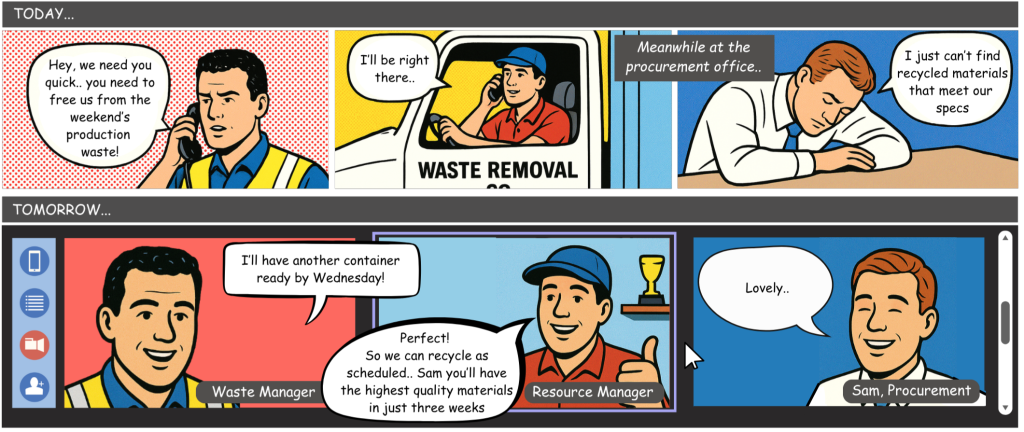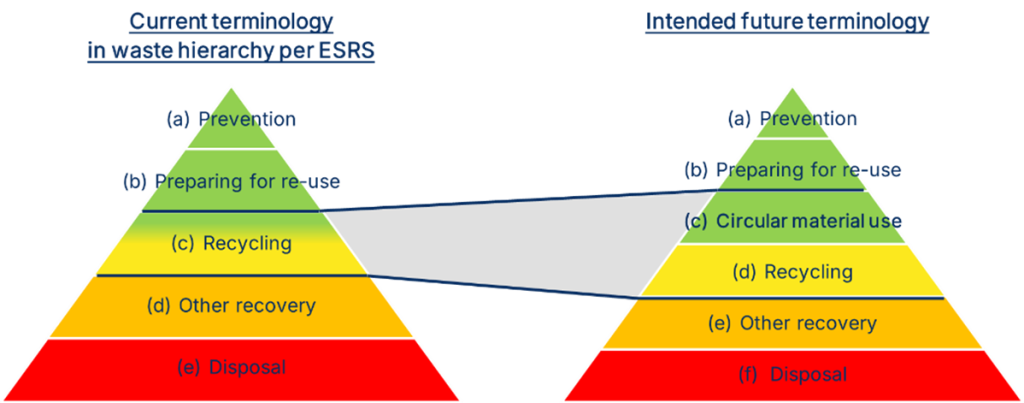We are delighted to share that the Alliance to Zero has successfully submitted our Consultation Statement to the EU Circular Economy Act! The consultation period has now closed. If you have any further questions please reach out to us at: info@alliancetozero.com.
Our key proposal introduces a new category in the Waste Hierarchy: “Circular Material Use”.
We need establish proactive, circularity-oriented corporate waste management based on end-to-end thinking that enables the availability of high-quality recycled materials.
In summary, our submission to the EU asks them to consider:
- Integrating “circular material use” into the logic of the waste hierarchy used in EU legislation
- Allowing the deduction of circular material volumes from total waste volume
- Enabling facilitation of circular reprocessing such as transportation of circular material across EU borders.
Read the complete draft of the Consultation Statement here.

Why do we need to act? Today, there is a scarcity of high-quality recycled materials
Legislation dictates how we all operate and is therefore an important lever for change.
Current legislation requires organizations to send their waste to a licensed waste dealer who then issues a certificate of legal compliance that includes the end-of-life treatment. Of the end-of-life treatments, “recycling” is the only category that exists for all further waste collection pathways that include material recovery.
Current waste management practices therefore focus on finding a partner that accepts a company’s waste volumes in a legally compliant way. Ideally, however, those partners would also offer access to a third party who would re-utilize that waste as a high value resource.
As a result, today’s standard recycling practices:
- Have the sole reprocessing responsibility with the recycling industry
- Pool material volumes into larger batch sizes to minimize reprocessing cost
There are two key problems with this practice for e.g. polymer applications is:
- Mixed feedstock, even when sorted for polymer type and color, results in an average polymer quality
- Current standard practices do not allow for traceability and thus control of potential contaminants
The consequence? A lack of high quality polymers.
- Applications that require high polymer quality (typically linked to long chain lengths) struggle to source recycled materials on the market
Hygiene-critical applications that need secure biocompatibility or are sensitive to outgassing at low concentrations cannot source recycled material at an acceptable standard.
How we can promote change? A mindset change guided by a new metric: circular material use
We need to encourage end-to-end thinking in corporate waste management programs that:
- Focuses on preserving maximum material quality in waste volumes
- Systematically establishes the reprocessing value chain, to connect corporate waste management, recycling services with future customers/users of those recycled materials
In this way, we can make recycled materials available for even those high-demand applications.
By doing this, we also enable compliance with the recycled content ambitions of the EU, reflected in the Packaging and Packaging Waste Regulations (PPWR).
We need the cooperation of the whole value chain to realize circular material use
To comply with the demand for high-quality waste for certain applications, waste collection needs to be run in prequalified, segregated and fully-traceable waste streams.
- Prequalification makes sure that only materials matching the future material requirements are entering the feedstock.
- Segregation prevents contamination with foreign materials and controls the material quality.
- Traceability across the reprocessing chain strengthens quality control and creates plannability.
To guide this mindset shift: We need an accepted metric, supported by legislation, to distinguish between circular material use and standard recycling (where responsibility is externalized).

With our collective submission to the EU Circular Economy Act, we are explicitly demanding the EU Commission:
- Adapt the waste hierarchy in European legislation by introducing a “circular material use” category. This category shall reflect volumes sent from their end-of-life location to controlled, segregated waste streams that deliver secondary raw material of the same specification as explicit inflow material volumes under surveillance of an EN 15343 audited traceability.
- Adapt the waste reporting metrics and guidance to explicitly foresee deduction of “circular material use” volumes from the total amount of waste generated.
- Create EU-wide, harmonized transport legislation that supports waste verified for circular material use to be transported easily and duty-free across EU borders.
Download our draft of the Consultation Statement here.
What can you do to promote this initiative?
The Alliance to Zero will submit our Consultation Statement on November 6th, the last day of the public consultation of the EU on its Circular Economy Act. See here for more details: Commission launches consultation for upcoming Circular Economy Act – Environment.
To maximise the impact of the initiative, the Alliance wants to gather support from organizations, companies and individuals as Supporter or Advocate.
To be successful we need YOU!
Level 1: Supporter
Sign up to support this initiative by November 5th!
- The more support we can demonstrate to policy makers, the higher the priority of our submission.
- There are no binding duties arising from signing up to support this initiative.
- When you sign (by completing the short form above), your name, function, company and country will be added to the list of signatories in our submission to the Consultation Statement of the Alliance, which will be uploaded on November 6th, 2025.
- Your next step: clarify with your company how you can sign up as representative or find a management representative of sustainability, procurement or other to support the initiative.
Level 2: Advocate
Share your support for this initiative with your network and advocate for circular material use
- By publicly sharing with your network, you are giving further credibility to this initiative and increasing the opportunity for us to engage more allies.
You find a draft of the Consultation Statement here.
Note: As our initiative only began in early October, we may need to adapt the wording of our submission based on further expert input or comments we receive to improve its potential impact on the EU Circular Economy Act. If we need to make a material change to our wording, we will contact all signatories in advance of submission. At its core, the initiative stands for integration of “circular material use” into the rationale of the waste hierarchy used in EU legislation, deductibility of circular material volumes from total waste volume and facilitation of boundary conditions to facilitate circular reprocessing such as transportation of circular material across borders. This will not change.
Any need for further information or if you have interest in collaborating on circular material use? Please contact us at info@alliancetozero.com
